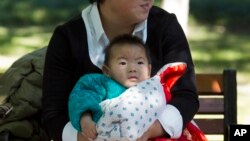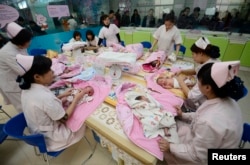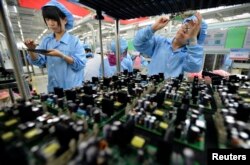China’s attention-grabbing decision to end its decades-old one-child policy and allow all couples to now have two children may become an opportunity to promote economic growth, analysts said.
But while the policy shift is expected to usher in new investments and boost consumption at a time when the economy it is slowing, it may also increase demand for higher wages and push up labor costs.
Chinese authorities Tuesday predicted that the new policy could raise economic growth by about half a percent and provide China with an additional 30 million laborers by 2050.
"More children means more maternity homes, hospitals, kindergartens and schools. It will certainly result in massive investment in these areas,” said He Weiwen, senior research fellow at the Chongyang Institute for Financial Studies in Beijing’s Renmin University.
'Contribute to economic growth'
“The two-child policy will also lead to more spending on the second child, and thus contribute to economic growth. The families having the second child will reduce their savings to meet the new requirement,” He said.
The government is expecting the two-pronged advantage of higher infrastructure investments and increased domestic spending to act as a stimulus for the economy.
When the new policy goes into effect, 91 million couples will be eligible to have a second child. The government expects that at least 60 percent of parents opting for the a second child will come from rural areas.
Inadequate health care and educational facilities in rural areas and small cities have long been a problem in China and because of that the government will have to take the lead by making fresh investments in these areas to reassure parents that proper facilities would be available if they opt for a second child.
What to Know About China's One-child Policy
China's One-child Policy
Policy: China first instituted its one-child policy in 1980 in a bid to control the country’s population, which is the world's largest, at nearly 1.4 billion.
Controversy: The restrictions have led to an imbalanced sex ratio because of a traditional preference for boys -- studies say there are 117 boys for every 100 girls. Also, heavy-handed enforcement sometimes included forced abortions and sterilizations.
Amendments: In late 2013, China began to allow couples, one of whom has no siblings, to have a second child.
Why the change: The Chinese Academy of Social Sciences estimates the workforce will being losing as many as 1.55 million people every year before 2020, 7.9 million between 2020 and 2030, and as many as 8.35 million between 2030 and 2050.
Will new policy help? Analysts say a two-child policy will do little to help lift the country’s declining birth rate or shrinking workforce.
Also, Professor Jiang Quanbao of Xi'an Jiantong University said too many people of child-bearing age may no longer want two children. And even with the new policy, it will take 20 years before those children could enter the workforce.
The Conference Board, a U.S.-based think-tank, said there are both positive and negative effects that might flow out of the two-child policy.
The group said that “from a consumption point of view, an increase in the number of children could have a positive impact on the consumption of products and services catering towards child rearing (similar to opportunities in industries catering towards China’s growing population in the older age groups), leading to growth and employment demand in those industries."
But it also warned of the negative impact in terms of rising labor costs, and greater pressure on aging grandparents who are often forced to take care of the young children of working mothers and fathers.
The main purpose of now allowing two children per family is to counter the aging population syndrome, and overcome a deficiency in labor supply, which threatens to upset future economic growth.
Challenges
But implementing the new policy may not be easy, said David Kelly, research director of the Beijing-based advisory group China Policy. The huge number of people involved in implementing the previous one-child policy may resist the change and the reallocation of the massive funding they controlled.
“Many provincial governments have a vested interest in not encouraging the new policy,” Kelly said.
There are other pressures that stand to test the success of the policy as well, he added.
“Two-income families may be reluctant to go for a second child because it will mean loss of job and incomes for the women at least for a short period. Besides, a vast number of women who underwent caesarian section during the first birth may not want to risk a second pregnancy,” Kelly said.
China has one of the world’s highest rates of caesarian section childbirth -- nearly 50 percent, according to a 2010 World Health Organization study. And global medical studies have widely highlighted the impact a C-section can have on mothers and their willingness to have another child after the procedure.










